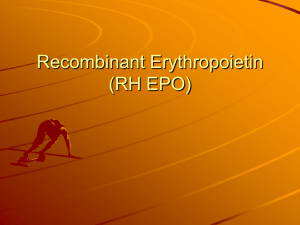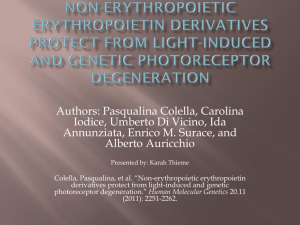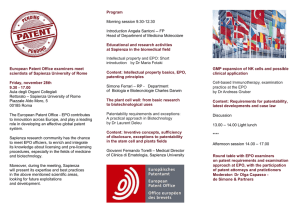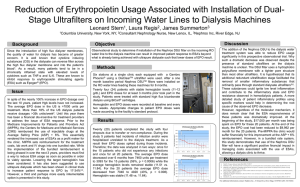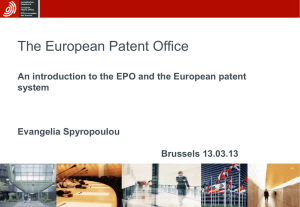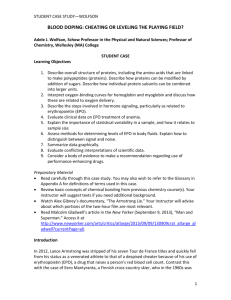Karah Thieme Term Paper
advertisement
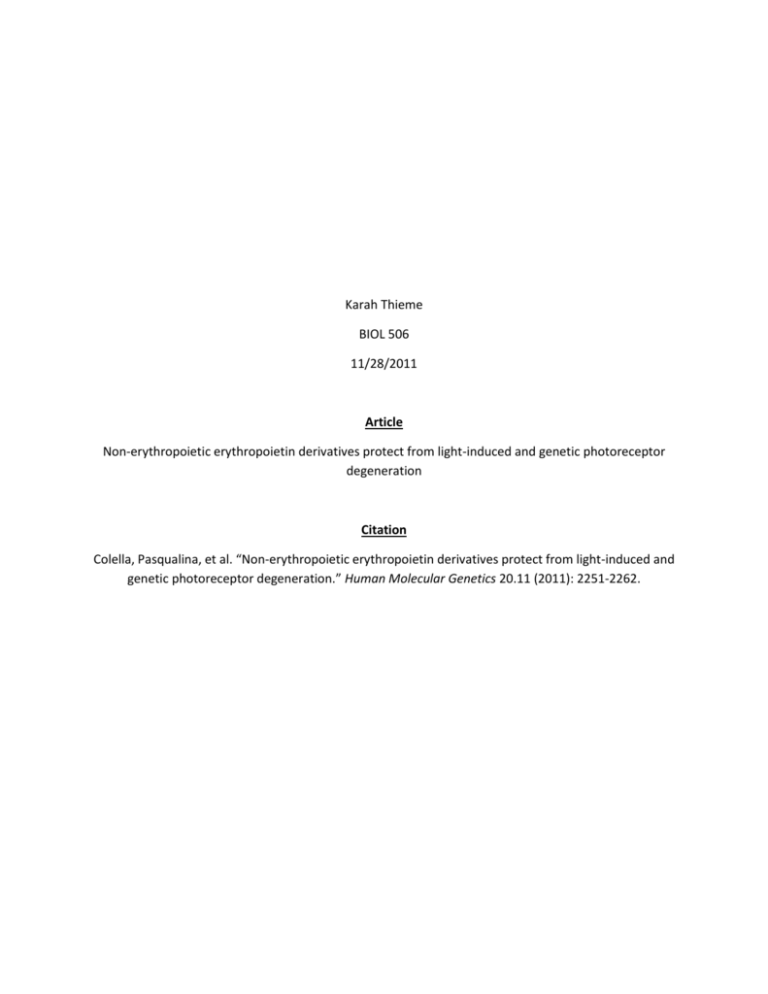
Karah Thieme BIOL 506 11/28/2011 Article Non-erythropoietic erythropoietin derivatives protect from light-induced and genetic photoreceptor degeneration Citation Colella, Pasqualina, et al. “Non-erythropoietic erythropoietin derivatives protect from light-induced and genetic photoreceptor degeneration.” Human Molecular Genetics 20.11 (2011): 2251-2262. Objectives Inherited retinal diseases (IRDs) are untreatable conditions that result in blindness by a common degenerative process where the photoreceptors (PR; rods and cones) of the eye die (PR apoptosis). IRDs are generally inherited in a Mendelian pattern and are highly heterogeneous, with mutations found in 208 genes thus far. Retinitis pigmentosa (RP) and Leber congenital amaurosis (LCA) are two examples of IRDs. Treatment of these diseases utilizing the molecular mechanisms of the different genetic defects is not currently a feasible option because the mechanisms are either not fully understood or not known at all. Nonetheless, there remains one possibility for treatment, which does not involve addressing the specific mutation or mechanism. The treatment would involve delivering genes or compounds into the patient that can prevent or slow PR apoptosis or maintain the survival of the PRs. The hormone being focused on for this treatment option is erythropoietin (EPO). EPO is a signaling molecule that promotes the propagation and differentiation of erythroid progenitor cells (one step involved in the process of making red blood cells aka erythropoiesis). EPO also has extraerythropoietic functions that are not related to erythropoiesis, such as anti-inflammation and neuroprotection. A complex under study in relation to EPO is the β common receptor (βCR), which interacts with EPO receptors (EPOR). βCR helps control EPO’s protective functions in some tissues, though the role it plays is debatable and suggests the involvement of an additional unknown tissueprotective complex. However, EPOR and βCR have been proven to be exhibited in the retina where they work together to mediate EPO protective functions. Depending upon where EPO is injected, different regions are protected. If delivered systemically, EPO protects the retina from light damage, genetic injury, ischemic injury, and glaucoma. However, if delivered intraocularly, EPO protects the retinal ganglion cells (RGC) from axotomy-induced degeneration, experimental glaucoma, and reduces neuronal and vascular cells apoptosis in models of retinal degeneration and diabetes. In order for EPO to have an effect, it must be delivered via viral vectors, which allows for sustained expression and avoids the need for repeated injections to treat IRDs. Adeno-associated viral (AAV) vector-mediated delivery of rhesus EPO has been shown to protect the retina of light-damaged rats and rds mice. However, systemic delivery has its side effects, such as increased hematocrit levels, thrombotic risk, and platelet hyper-reactivity. To study EPO protection of PRs, three non-erythropoietic EPO derivatives (EPO-D) were engineered, which help retain tissue-protective functions and other hormone side-effects. The three EPO-Ds are EPO mutant S100E, helix-A derived peptides (NP2), and helix-B derived peptides (NP1). Once it was established what complex/deriviatives were to be tested in protecting against PR degeneration, two objectives were determined. The first was to determine if delivery of nonerythropoietic EPO-D could represent a mutation-independent treatment for IRDs, which would be safer than EPO because it would lack EPO’s systemic side effects. The second objective was to learn more about the contribution of different EPO functions in retinal protection, such as how erythropoietic functions compare to non-erythropoietic functions. The method used to evaluate the objectives were comparing the effectiveness of systemic versus subretinal (SR) AAV-mediated delivery of EPO or one of the EPO-D in models of PR degeneration. The models used were: rat and murine models of light- induced retinal degeneration and rds (retinal degeneration slow) and Aipl1 (aryl hydrocarbon receptor interacting protein like-1), which recapitulates RP and LCA. Experimental Approach and Results The first test was done to analyze the expression profile of known EPORs to determine if a local effect could be produced after SR AAV-mediated delivery of EPO and EPO-D and which are the EPO and EPO-D target cells in the retina. The EPOR and βCR expression pattern was defined by in situ hybridization analysis (ISH) on retinal sections from 4-week-old CBA mice, which showed that most EPOR and βCR were expressed in RGC, in the inner nuclear layer, and somewhat in the PR. Second, the hematocrit levels and the functional and morphological PR preservation after EPO and EPO-D gene delivery were assessed. To perform the gene transfer, AAV-1 based vectors (AAV2/1) were created. The vectors provided an efficient outer retina transduction and intraocular secretion of the treatment, and they coded for either EPO or one of the EPO-Ds (S100E or NP1-NP2). The vectors were injected systemically or subretinally into Lewis rats which are a useful model for induced retinal degeneration, and four weeks after administration, the protein levels for EPO and S100E were measured by ELISA assay. If injected subretinally, there was increased protein level in the anterior chamber fluid (ACF). If injected systemically, there was increased protein level in the sera of the rats, and they also found detectable level of both proteins in the ACF, which shows that EPO and S100E can cross the blood-retina barrier. As for hematocrit levels, SR injection of EPO showed a slight increase, although it is most likely due to leakage of the hormone into circulation. Also, SR injection of S100E and NP1-NP2 showed no increase in hematocrit. Systemically delivered EPO, on the other hand, had a significant increase in hematocrit levels, while systemic delivery of S100E only had a slight increase. This difference demonstrates that S100E has less erythropoietic activity than EPO. In order to assess the retinal function, electroretinographic analyses (ERG) was utilized. ERG showed that systemic deliver of vectors encoding for EPO or S100E, but not NP1-NP2, significantly preserved retinal function after light damage. PR protection was seen after SR injection of S100E, which suggests that EPO-mediated neuroprotection can be accomplished without erythropoiesis. Additionally, other systemic effects of the hormone may come into play with PR preservation because the effect is more potent with systemic injection than SR. An increase in PR survival was associated with a significant increase in hematocrit after a systemic injection of vector encoded EPO or S100E. However, PR survival was associated with only a slight hematocrit increase for SR injection of vector encoded EPO. Finally, the hematocrit levels and PR survival after gene transfer of EPO and EPO-D to the retina of rds and Aipl1-/- mice was evaluated. The authors first tested to see if EPO and EPO-D gene delivery protected from IRD. The rds mouse is homozygous for a null mutation in the peripherin 2 gene, which, among other things, causes progressive PR loss. The Aipl1 knockout mouse lacks retinal function and exhibits fast degeneration of PRs due to the destabilization of an enzyme (phosphodiesterases) needed for PR survival and function. Both mouse types were injected either systemically or SR with AAV vectors during their first postnatal week, and then studied on postnatal day 90 and 21 (depending on timing of PR loss). EPO and S100E were detected in the sera and ocular fluids of rds (90). And also in the sera of Aipl1-/- (21), which confirmed that there was efficient transduction in the experimental groups and that EPO and S100E cross the blood retina barrier from circulation. After systemic or SR injection of EPO (in both types) there was a significant increase in hematocrit levels, though the SR increase was due to it leaking into circulation as before. Systemic injection of S100E exhibited lower hematocrit levels compared to EPO delivery by the same method, which confirmed the low-erythropoietic activity of S100E in vivo. The significant higher levels of PR survival seen after systemic delivery of EPO or S100E with a hematocrit increase confirmed that the systemic activities of the hormone in combination with its local functions provided a majority of the retinal rescue. Conclusion This study shed further light on EPOs diverse function in the body, and the role that EPO-D could play in place of EPO to avoid the systemic side effects. The authors investigated whether erythropoietic activity was necessary for PR protection by studying the different effects of EPO and EPO-D and the resultant hematocrit increase. PR protection resulted with systemic delivery of S100E in the three different models of retinal degeneration, which suggests that EPO erythropoietic activity is not required (recall S100E has low erythropoietic activity in vivo). This was further confirmed because the intraocular delivery of EPO-D and lack of hematocrit increase (a sign of erythropoietic activity) still resulted in PR protection. Consistently, PR protection was better after systemic injection than intraocular, and there are three possible reasons: non-erythropoietic systemic functions of the hormones may be involved and aid in the protective effect, may be tissue-specific modifications that alter the proteins after transduction of muscle or retina, or there is an inverse relationship between the hormones effectiveness and their concentrations with the highest effectiveness obtained at the lowest intraocular concentrations. EPO and EPO-D injected SR by AAV-mediated delivery was shown to provide PR protection, and does so without a significant hematocrit increase with the EPO-D. This proves that there is local protective effect from light-induced degeneration though it is not as strong as the systemic delivery method. Systemic or subretinal injection of NP1-NP2 did not produce any real effect or protectiveness to the extent that S100E had. The practical lack of expression of NP1-NP2 may be due to the plasma’s short half-life. The authors were unable to test its expression or secretion because the peptides are too short and do not have the appropriate antibodies. Therefore, they could not determine if the lack of effectiveness from the muscle was attributed to inappropriate expression/secretion or the short plasma half-life. Opinion for Future Research Because S100E showed the most promise of the EPO-Ds, further research should be done to explore it as a treatment option for IRDs. S100E should be tested further alongside EPO to measure the effectiveness of both treatments, aside from reduced side effects to patients by using S100E. Since EPO is known to be a potential effective treatment for IRDs, research into reducing its side effects should be explored in the case that it is more effective than S100E. Also, delivery via the systemic route should be focused upon because it had greater protective effects, most likely due to other yet unknown systemic factors. However, if concerned with an IRD that requires faster delivery of treatment, then the subretinal route should be further explored as it provides a faster, more direct mechanism.
